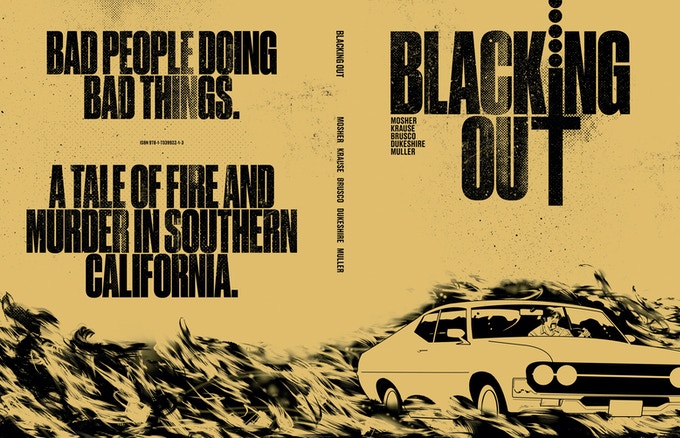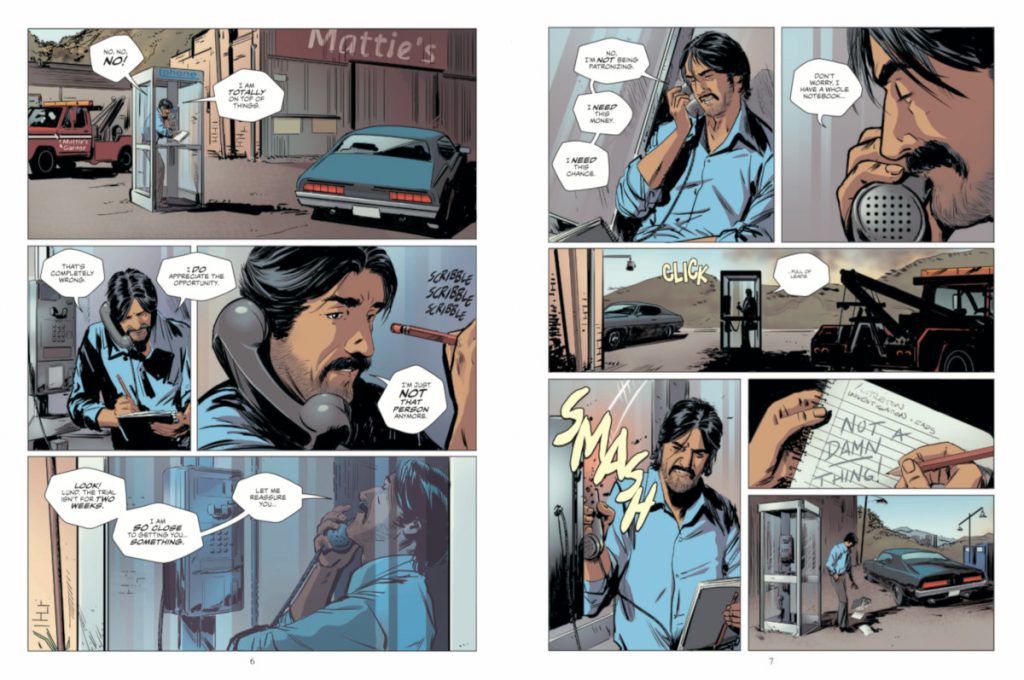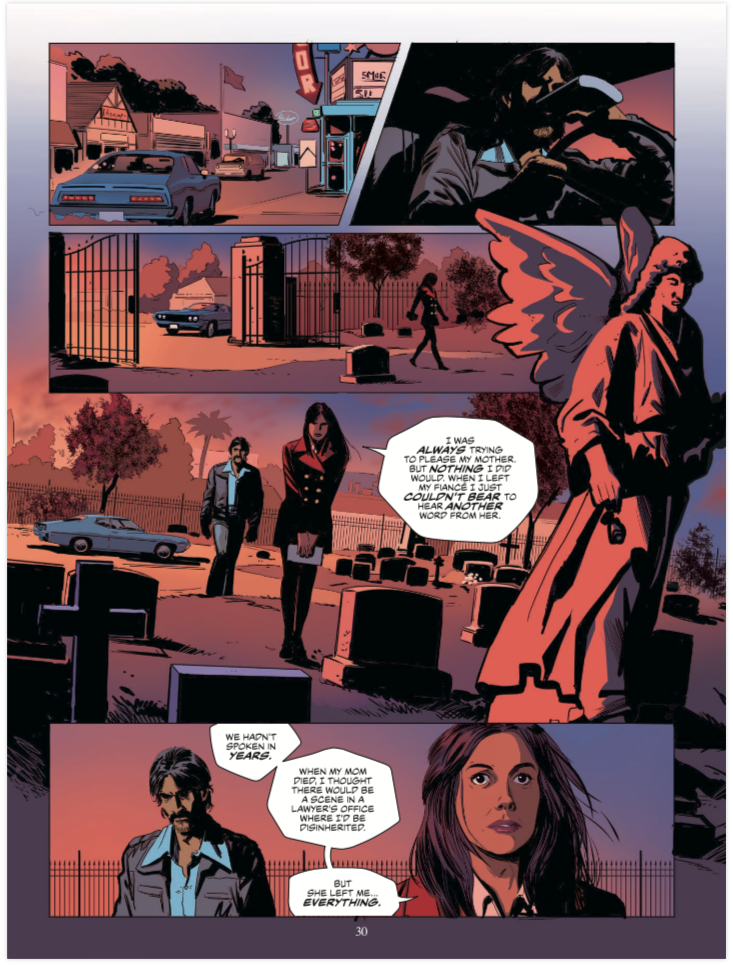Ten Years in the Making: Chip Mosher on Kickstarting “Blacking Out”
Comics being Kickstarted isn’t necessarily always interesting, as that occurrence happens a lot. It’s fairly run of the mill these days, and they still need to be relevant to your interests to draw your attention. The currently being Kickstarted graphic novella Blacking Out manages to do that in a number of ways. It’s drawn by Peter Krause, a tremendous visual storyteller who might not get as much credit as he deserves. It’s designed by Tom Muller, the very best in the business. It has unconventional marketing plans behind it, including billboards (!!), amongst other things. And it’s written by Chip Mosher, someone I’ve mostly engaged with in his work previously at BOOM! Studios and currently at ComiXology, where he’s a big part of their ComiXology Originals program.
Combine all of that with the fact that Blacking Out is an oversized – think bande dessinée size – graphic novella in the crime genre, a genre that’s always intriguing to me but not always super well executed, and you have a very interesting project indeed. With that in mind, I chatted with Mosher about the ins and outs of this project, exploring why he decided to make his return to writing comics after a decade away and why he wanted to fund it on Kickstarter given his assuredly considerable options. Give it a read below, and hey, if you find yourself intrigued by the sound of Blacking Out, its Kickstarter ends in five days, so get on it!

You work in comics, but you don’t actually make a lot of comics yourself. What made you want to get back in the game? And aren’t you busy enough?
Chip Mosher: (Laughs.) Oh man, yeah. You know when to quote my main character Conrad, “If you don’t make obstacles for yourself life just gets boring.” But seriously, I’ve wanted to get another book out since… well, my last book came out. But I really wanted to do it on my own terms. So several years back I kicked off this process with Pete and… here we are.
What came first: the idea for Blacking Out or the desire to write comics again?
CM: Blacking Out was going to be my quick follow up to my previous book, Left On Mission, that Francesco Francavilla and I did. A version of it was sitting in a drawer collecting dust for some time. But once I had the vision and ability to do the book the way I wanted to do it, I called Peter Krause up and the rest is history.
I’m a big fan of crime/noir stories in comics, but they’re rarely something people connect with in a big way outside of Brubaker and Phillips. What made you want to tell a story in that vein, and to do what you can to flip the idea they don’t connect with readers on its heads?
CM: Brubaker and Phillips are really the gold standard when it comes to crime comics, right? That said, I’ve been a huge fan of what Gary Phillips has done with the genre, too, in comics, going back to his Oni Press output with Jim Mahfood. Shot Callerz. I like stories about bad people doing bad things, and so I connect more on the noir side of the crime genre. I never have problems connecting with characters, I think we all have shadow selves. But maybe that tells you more about me than it should.
Peter is someone I mostly know for superhero related work, but as soon as I saw he was working on effectively a crime/noir story, it made sense to me. What makes him such an ideal fit for this story?
CM: I’ve been friends with Pete going back to the Irredeemable days… and he’s sent me some story boards and other work over the years, so I think I had a better idea of his versatility than most. Also, just talking to him and knowing his influences. Too often artists and writers get pigeonholed in this industry—and frankly most creative industries. So it was great to see him work on something that no one expected him to work on… It’s funny, ‘cause his work on this book was finished a year and a half ago, and he and I have both shown it to a ton of people. So I think you’ll be seeing a renaissance of Krause work that is non-superhero soon! I can’t say anything about the writing, but Pete’s work on Blacking Out has few peers. I’m honored to have anything to do with a talent like Pete.

The rest of the team is fantastic as well, with Giulia Brusco on colors, Ed Dukeshire on letters, and the always incredible Tom Muller on design. What made each of them the right fit for the book, and did the squad come from you recruiting, or was it you and Peter doing it together?
CM: Pete and I worked together and picked the creative team. I’ve worked with Ed since the early BOOM! days and if you look at his work on Irredeemable, especially that first issues, he’s doing stuff with word emphasis that is just amazing and so natural. Changing the size of one word in a balloon, changing the font… Ed’s got a great eye. I joked with Mark Waid that I stole his Irredeemable team, and that’s kinda true. Giulia is someone who’s work just has blown me and Pete away over the years. Her colors on Scalped are just amazing and really just added a whole dimension to that book. She really knows how to level up a scene. And Pete and I have both been a huge fan of Tom’s since day one.
Design is something plenty of creators either skip out on entirely or do the bare minimum on. You…did the opposite of the bare minimum here, as Tom is straight up the best. Why was that so important to you when it came to bringing this comic to life?
CM: I’m a huge design snob. When BOOM! was tiny, I oversaw the trade design, because that is what a Marketing Director does, right? (Laughs.) I remember designing the Potter’s Field hardcover at BOOM! We did a metallic ink on the cover wrap, with an emboss on the case cover, and a silver bookmark ribbon. I pushed the envelope on all the bells and whistles—that was the book that got me to fall in love with that process. So design is important to me and, artistically, good design informs how someone approaches a book and what they get out of it. We approached Tom before Pete started doing pages and kept him abreast of the process. And then he came in at the end, created the logo and art directed Pete on the cover and designed the cover. Once you read the story and then look at the cover, you’ll have an “aha” moment. It’s really, really stunning work and I couldn’t be prouder to be associated with something Tom worked on.
This isn’t just a graphic novel, but a deluxe, oversized hardcover graphic novel. I’m all for that. I’m here for giant comics. Why giant size it, though? Was it just because this was a pure, do it yourself, make the comic you want to kind of project, or was it something else?
CM: In France, what we consider oversized European albums are the norm, known as bande dessinée or BD for short… and the BD are usually 48 pages in length. I sent Pete some BD from France to show him what I was thinking as we started talking about Blacking Out. I’ve been really inspired by my work trips to France and love that format and how much more the width of the pages give the artist to tell a story. It also gives a big canvass on the cover for Tom and Pete to do their thing.

Speaking of, this is a fascinating project because of how it’s coming together. It’s being Kickstarted for seemingly printing purposes alone, as the comic is already completed. You’re a connected guy. You could have done this all kinds of ways – print, digital, through a publisher, self-published a different way – but you chose Kickstarter. Why was this the direction you wanted to go when you surveyed your options?
CM: (Laughs.) Well, being connected can be a problem, too. I wanted to and needed to have a clean separation between my two worlds—keep it church and state. A few years back, I helped my wife with the Kickstarter for a book on Femme Fatales as we like our noir in this family. I’m a big fan of Kickstarter and wanted to have a direct avenue to get the book in the hands of fans without compromising the creative vision for the book. Blacking Out has been put together with a very particular vision in mind. I hope at one point we’ll get more mass distribution for the work, but I wanted to do it in the BD format… which is not cheap, and not standard, and who knows if a mass market publisher would want to handle it this way. Worst case, the book will be printed the exact way we envisioned and then will become a very limited edition collector’s item.
This one is simple: why was your goal only $500? That was one of the most surprising parts of the project.
CM: We changed this at the last moment. I struggled with what to ask for… and was going to ask for all the funds to print, which is about $7,500 at the lowest quantity possible. As I lived with the Kickstarter in preview for a while, it just struck me as wrong to ask for that much money during COVID-19. If worse came to worse, I could cover the cost for printing. So I dropped it down to something nominal. So that’s what drove the $500 goal.
When you were coming up with rewards for the project, what made lobby cards the right fit? I love the idea, and it feels contextually relevant, but I’m curious as to what led you there.
CM: The Lobby Cards let us celebrate the film noir tradition and give Pete and I a chance to work with a ton of people we’re huge fans of. So it wasn’t the hardest sell in the world to do it!
Comics marketing is a tough job, and there are a lot of different ways you can get the word out. How different was your approach because it was simply promoting the Kickstarter itself, and I have to ask, how did billboards in Los Angeles make it into the mix?
CM: Comics marketing is the toughest job you’ll ever love. (Laughs.) Seriously, comics marketing is a breeze. It’s something that comes too easy to me. Writing… not so much. The billboards are something my wife’s last publisher did for her book debut and the rates are incredibly reasonable… So I was racking my brain on a way to spotlight those pull quotes in a way that was deserving. Waid, Azzarello, and Derf are all super busy guys, they took time out of their schedules to read the book and write up quotes… and the book is done. So these won’t appear on the back cover. So at very least I wanted to show those three how much it meant to me, and… then I’ll survey the backers to see if it moved the needle. I like experimenting and doing new things. It’s kinda what I’m known for. So it’s fun to push the envelope even if the best thing I got out of it was a picture.
It’s been quite some time since your last comic project. Is it going to be another ten years until your next one, or has this experience fueled interest in you to tell even more stories?
CM: David, you’ll have to wait for 2030 to find out! (Laughs.) Seriously, I’m averaging a book every 10 years and this one is half the size of the last one. So the next one might be a single issue one-shot spectacular. But seriously, you never know. I have a bunch of ideas kicking around and Pete is bugging me about one of them… so who knows!
Did you enjoy this interview? Consider subscribing to SKTCHD for pieces like this and more.
